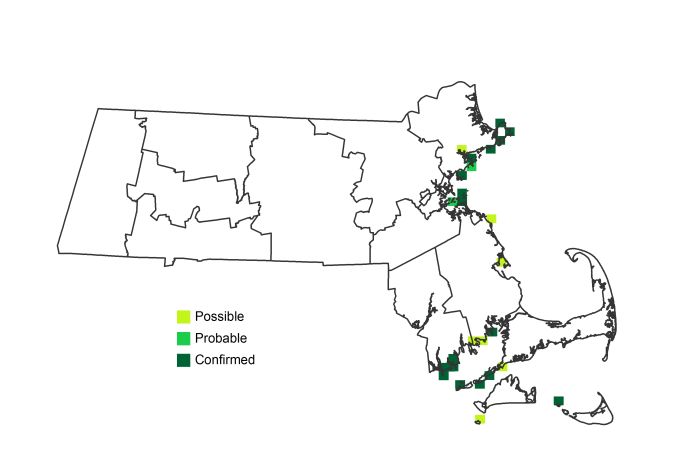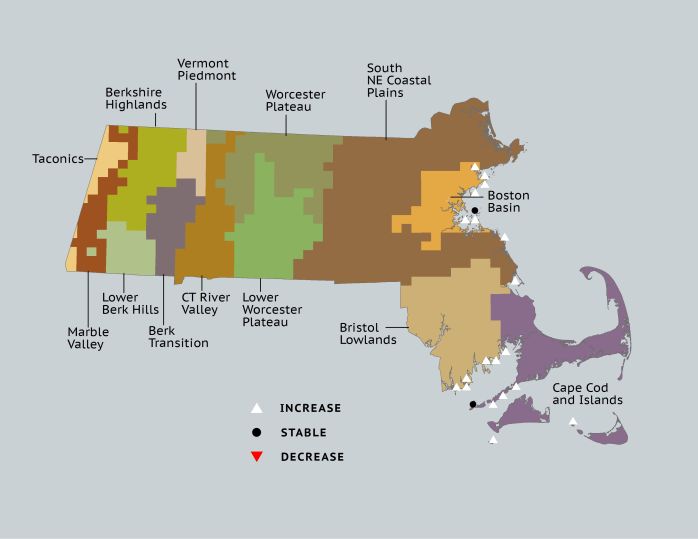Find a Bird
Common Eider
Somateria mollissima

Local and strongly increasing
State Wildlife Action Plan listed
“Our Canadian neighbors might reap a rich harvest by conserving these birds after the manner of the Scandinavians and Icelanders who kill no Eider Ducks, but take the down and some of the eggs from the nests, securing thereby much good food and a yearly revenue.” – Edward Howe Forbush, Birds of Massachusetts
Famed for its soft downy feathers, which find their way into coats, pillows, sleeping bags, and more, the Common Eider is a marine duck through and through. The species usually nests colonially on shorelines and dives in salt water for aquatic invertebrates, especially mussels and other mollusks. With eggs, meat, and feathers in demand, breeding eiders were all but wiped out in Maine and other northern areas for many years. Fortunately, prospects for their recovery are more optimistic today.
Historic Status
Early observers of the eider duck in Massachusetts rated it as abundant in the state, especially in Boston Bay, and off Martha's Vineyard and Nantucket. The widespread depredation of Common Eiders by activities such as shooting, egging, and feather collecting eventually caused a major decline in this species’ numbers in Massachusetts. Peabody (1839) suggests that, while eiders once bred from Boston eastward, Massachusetts was probably the very southern edge of the species’ breeding range. Ultimately, its status was reduced to that of a scarce winter resident. By the beginning of the twentieth century, eiders were practically a rarity in New England. Maine, once a thriving breeding ground, was down to approximately two nesting pairs in one colony by 1907 (Allen 2000). The species dramatically rebounded in the 1930s, however, following legal protection and the elimination of the ruinous activities that had previously nearly caused the species’ extirpation in New England.
Atlas 1 Distribution
Though large rafts of Common Eiders were an annual occurrence in Massachusetts during the winters of the Atlas 1 years, the species was only just beginning to reestablish itself as a breeding species in Massachusetts at that time. Introduced birds and their descendants were Confirmed breeding in 2 blocks on the southernmost parts of the Elizabeth Islands in the Cape and Islands region. Another Possible block in Boston Harbor hints that these northern sea ducks might have already been on their way southward to breed in Massachusetts even without human intervention.
Atlas 2 Distribution and Change
Common Eiders have today become a fairly common breeding species along the coast of Massachusetts, and they even appear to be spreading southward as far as coastal New York. The number of blocks in which they increased gives a false impression of the scale of their growth since there are now hundreds of breeding pairs with young reported all along our rocky coastlines of Massachusetts, though they are less common as breeders on the sandy moraine of Cape Cod.
Atlas 1 Map

Atlas 2 Map

Atlas Change Map

Ecoregion Data
Atlas 1 | Atlas 2 | Change | ||||||
Ecoregion | # Blocks | % Blocks | % of Range | # Blocks | % Blocks | % of Range | Change in # Blocks | Change in % Blocks |
Taconic Mountains | 0 | 0.0 | 0.0 | 0 | 0.0 | 0.0 | 0 | 0.0 |
Marble Valleys/Housatonic Valley | 0 | 0.0 | 0.0 | 0 | 0.0 | 0.0 | 0 | 0.0 |
Berkshire Highlands | 0 | 0.0 | 0.0 | 0 | 0.0 | 0.0 | 0 | 0.0 |
Lower Berkshire Hills | 0 | 0.0 | 0.0 | 0 | 0.0 | 0.0 | 0 | 0.0 |
Vermont Piedmont | 0 | 0.0 | 0.0 | 0 | 0.0 | 0.0 | 0 | 0.0 |
Berkshire Transition | 0 | 0.0 | 0.0 | 0 | 0.0 | 0.0 | 0 | 0.0 |
Connecticut River Valley | 0 | 0.0 | 0.0 | 0 | 0.0 | 0.0 | 0 | 0.0 |
Worcester Plateau | 0 | 0.0 | 0.0 | 0 | 0.0 | 0.0 | 0 | 0.0 |
Lower Worcester Plateau | 0 | 0.0 | 0.0 | 0 | 0.0 | 0.0 | 0 | 0.0 |
S. New England Coastal Plains and Hills | 0 | 0.0 | 0.0 | 6 | 2.1 | 23.1 | 2 | 0.9 |
Boston Basin | 1 | 1.8 | 33.3 | 7 | 12.5 | 26.9 | 6 | 10.9 |
Bristol and Narragansett Lowlands | 0 | 0.0 | 0.0 | 7 | 6.1 | 26.9 | 6 | 5.9 |
Cape Cod and Islands | 2 | 1.5 | 66.7 | 6 | 4.2 | 23.1 | 5 | 4.2 |
Statewide Total | 3 | 0.3 | 100.0 | 26 | 2.5 | 100.0 | 19 | 2.3 |



